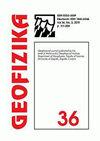使用模糊c均值算法定义土耳其的降雨强度集群
IF 1.1
4区 地球科学
Q4 GEOCHEMISTRY & GEOPHYSICS
引用次数: 2
摘要
土耳其有七个传统上公认的气候带,这些气候带主要受海洋和地形的影响。在这些地区,年降雨量,包括其强度和季节分布,差别很大。这些变化对城市和农村社区都有影响,包括水资源短缺和山洪暴发事件的发生,由于全球变暖和气候变化,这些变化的频率和幅度都在增加。土耳其有几种不同类型的气候,用不同的方法确定了气候带。为了更好地了解土耳其各地的降雨强度模式,本研究使用模糊c均值(FCM)算法来定义其空间分布。在第一阶段,从土耳其国家气象局经营的95个站点获得了30至78年期间的年最大降雨强度记录,并汇编了这些站点的经度、纬度和高度数据用于聚类分析。第二阶段对所有降雨强度和地理值进行归一化处理,第三阶段采用FCM算法。年最大降水强度比较显示出5个簇。四个集群被确定为离散区,一个集群被确定为过渡区。位于不同地理区域的气象站有时会归入同一群。换句话说,相似强度的降雨事件可能发生在不同的气候带。该研究为聚类研究带来了不同的视角,表明FCM技术可以成功地分析全国范围内的降雨强度值。本文章由计算机程序翻译,如有差异,请以英文原文为准。
Defining rainfall intensity clusters in Turkey by using the fuzzy c-means algorithm
Turkey has seven traditionally accepted climatic zones that are defined primarily by maritime and topographic influences. Across these zones, the annual amount of rainfall, including its intensity and its seasonal distribution, vary considerably. These variations, which impact on both urban and rural communities, including the occurrence of water shortages and flash flooding events, are increasing in both frequency and magnitude due to global warming and climate change. Several types of climate occur in Turkey where climate zones have been defined with various methodologies. To better understand rainfall intensity patterns across Turkey, this study used the Fuzzy C-Means (FCM) algorithm to define their spatial distribution. In the first stage, the annual maximum rainfall intensity records for periods ranging from 30 to 78 years were obtained from 95 stations operated by the Turkish State Meteorological Service, and the longitude, latitude and altitude data for the stations were compiled for cluster analysis. Secondly, all rainfall intensities and geographical values were normalized, and in the third stage, the FCM algorithm was applied. The comparison of annual maximum rainfall intensities revealed five clusters. Four clusters were identified as discrete zones and one was identified as a transitional zone. Weather stations located in different geographical regions sometimes fell into the same clusters. In other words, rainfall events of similar intensity can occur in different climatic zones. This study, which brought a different perspective to clustering studies, showed that rainfall intensity values can be successfully analyzed at a national scale with the FCM technique.
求助全文
通过发布文献求助,成功后即可免费获取论文全文。
去求助
来源期刊

Geofizika
地学-地球化学与地球物理
CiteScore
1.60
自引率
0.00%
发文量
17
审稿时长
>12 weeks
期刊介绍:
The Geofizika journal succeeds the Papers series (Radovi), which has been published since 1923 at the Geophysical Institute in Zagreb (current the Department of Geophysics, Faculty of Science, University of Zagreb).
Geofizika publishes contributions dealing with physics of the atmosphere, the sea and the Earth''s interior.
 求助内容:
求助内容: 应助结果提醒方式:
应助结果提醒方式:


